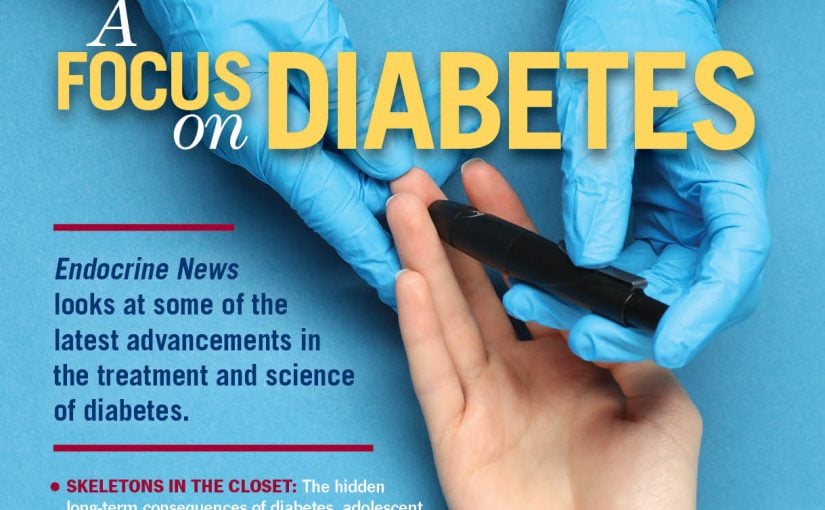For the tenth year running, Endocrine News talks to editors from Endocrine Society publications to unearth the most impressive breakthroughs in endocrine science and research for 2024. This year, we also talk to some of the “scientists behind the science” to get their insights on their cutting-edge research.
For the 10th year running, Endocrine News talks to editors from Endocrine Society publications to unearth the top endocrine discoveries of 2024 and the incredible scientists behind them.
Despite this being Eureka’s “tin anniversary,” these studies are pure gold, as selected by Endocrine Society journal editors-in-chief as well as associate editors as what they consider the top endocrinology studies published in the last 12 (or so) months.
These discoveries bridge molecular mechanisms through clinical applications and share a common thread: the increasing recognition that endocrine disorders require more personalized and nuanced approaches to treatment, whether in cancer therapy, metabolic disease, or age-related conditions.
Scientists have illuminated the complex interplay between hormones and systemic health. The discovery of brain-derived cellular communication factor 3 (CCN3) has revealed previously unknown connections between biologic systems, while new insights into the hormone LEAP2 have expanded our understanding of metabolic regulation. These findings are complemented by research showing how liver androgen receptors differently influence metabolic health in males and females, highlighting the importance of sex-specific approaches to endocrine disorders.
In the therapeutic realm, researchers have made significant strides in multiple areas: from targeted radiotherapy for metastatic pheochromocytomas to innovative approaches for preserving beta cell function in diabetes. Advances were also made in understanding the extraskeletal benefits of parathyroidectomy and the potential of combining glucagon-like peptide (GLP)-1 receptor agonists with lifestyle interventions for optimal outcomes in weight management.
Findings related to the clinical heterogeneity of polycystic ovarian syndrome (PCOS) and the varying predictive value of sex hormone–binding globulin (SHBG) levels across different populations emphasize the need for more individualized treatment approaches. This trend extends to the management of autoimmune endocrinopathies and early puberty, where both genetic and environmental factors are now better understood.
These discoveries — thanks to the scientists who made them — collectively promise to revolutionize patient care through more precise, personalized treatment strategies. By deepening our understanding of endocrine system complexity and its far-reaching effects on human health, these advances are paving the way for more effective interventions that can be tailored to individual patients’ needs, ultimately leading to better outcomes across a broad spectrum of endocrine disorders.
From the Editor of Endocrine Reviews

Endocrine Reviews Editor-in-Chief Ashley Grossman, FMedSci, emeritus professor of endocrinology, University of Oxford; senior research fellow, Green Templeton College; consultant NET endocrinologist, Royal Free London; professor of neuroendocrinology, Barts and the London School of Medicine; and consultant endocrinologist at the London Clinic Centre for Endocrinology, in the U.K., chose three JCEM publications he says will impact clinical practice.
The first is a very detailed and comprehensive review of targeted radiotherapy for metastatic pheochromocytomas/paragangliomas from September titled “Approach to the Patient: Concept and Application of Targeted Radiotherapy in the Paraganglioma Patient,” by Pacak K., Taieb D., Lin F.I., and Jha A. “In recent years, targeted radiotherapy for these tumors has become increasingly popular due to accumulating evidence of efficacy, in spite of the lack of large-scale controlled trials, with few of the adverse events associated with more conventional forms of treatment,” Grossman says. “High-activity 131I-MIBG has unfortunately been withdrawn, but the effectiveness of peptide receptor radionuclide therapy with 177Lu-dotatate suggests that this will soon be the initial treatment of choice and should be actively considered by all physicians dealing with these fascinating tumors. The article is very comprehensive and well-illustrated.”
Grossman’s second pick is from July. “Also, in the area of endocrine oncology,” he says, “one not infrequently comes across patients with a MEN1 phenotype but negative genetic screening. Could these have MEN4, due to mutations of the CDKN1b gene responsible for the tumor suppressor p27?” In, “Beyond MEN1, When to Think About MEN4? Retrospective Study on 5,600 Patients in the French Population and Literature Review,” by Chevalier B., et al., among a very large French cohort investigated for MEN1, only four patients were identified as having MEN4. “These patients had milder disease, less frequently had pancreatic neuroendocrine tumors, and were diagnosed at an older age with hyperparathyroidism,” Grossman says. “This is clearly a very rare syndrome and should cause us a little less concern that we are missing the diagnosis on routine gene panel screening.”
“Returning to primary hyperparathyroidism,” he says, “it is often quite difficult to decide when surgical intervention is required, in spite of various guidelines to assist us. In particular, is there truly an improvement in bone architecture following selective parathyroidectomy?” In “Skeletal Effect of Parathyroidectomy on Patients With Primary Hyperparathyroidism: A Systematic Review and Meta-Analysis,” from July, Kongsaree N., et al. undertook a detailed review and meta-analysis, including 233,188 patients with hyperparathyroidism. “Fractures at any site were reduced, specifically hip fractures, although not in spine or radius fractures, and interestingly associated with only minimal changes in bone density,” Grossman explains. “They concluded that indeed there are improvements to be expected in bone architecture at the hip following parathyroidectomy, an argument that can be considered in some borderline patients being considered for this operation. This will certainly influence my approach to such patients with primary hyperparathyroidism, in particular those with borderline indications for operation.”
More From the Editors of Endocrine Reviews
Lauren Fishbein MD, PhD, MTR, assistant professor in medicine at the University of Colorado School of Medicine in the Division of Endocrinology, Metabolism and Diabetes and an associate editor of Endocrine Reviews chose “Outcomes of SDHB Pathogenic Variant Carriers,” by Davidoff D.H., et al. from the September issue of JCEM. “This systematic review provides data about those who carry a germline succinate dehydrogenase type B (SDHB)pathogenic variant (PV),” Fishbein says. “This is a rare/understudied condition. Those with SDHB germline PVs are at risk for developing hereditary paraganglioma-pheochromocytoma syndrome. We are finding more incidental genetic mutations or pathogenic variants through genetic testing for other reasons — part of biobanks or done for other cancers in the family, etc. The authors for this paper focus on those non-probands who have SDHB PVs and do a systematic meta-analysis for the risk of developing pheo/para, developing multifocal pheo/para and developing metastatic disease. Their work suggests there is a lower risk than previously reported for those with SDHB PVs to develop pheo/par and also a lower risk of developing metastatic disease than previously reported. These data may change our clinical management and our counseling of patients as we find more and more individuals with incidental pathogenic variants through more and more genetic testing for other reasons.”

